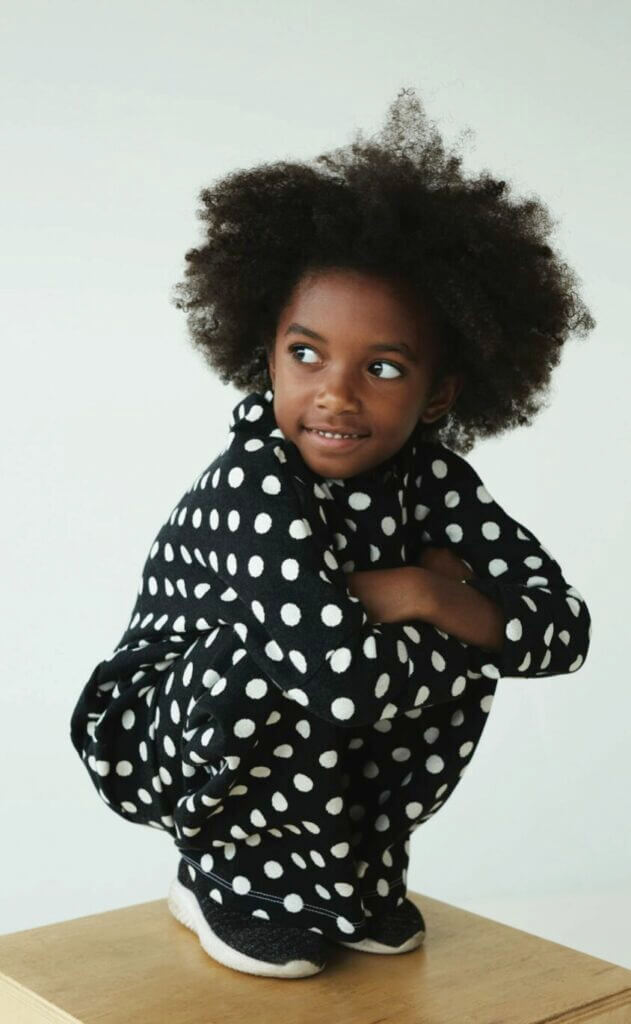Next-gen gender
Parents and designers are taking kids' fashion to the next level
Isabel Harder

Photo courtesy Kid’s Stuff [Trucs d’enfants]
Gender-neutral clothing is a growing trend in Canadian fashion, and one that is trickling down to the wardrobes of the youngest Canadians.
From chains such as La Tuque, Quebec’s Aubainerie, to small businesses such as Vancouver’s Pley Clothes, options for parents looking to build their children a genderless closet are growing across the country. Brands appear to be thriving in Canada’s larger cities and fashion hubs, including Vancouver, Montreal and Toronto.
Ideas of gendered children’s clothing have been evolving since the 19th century, when pastel colours for children came into fashion. Some historians say the idea of “pink for girls, blue for boys” only fully solidified itself in the public sphere in the 1940s.
Now, it seems these old ideals of gendered colours are being given up in favour of attitudes toward clothing that allow for self-expression in any colour or style, regardless of gender.
The industry is still in its early stages and its numbers can fluctuate due to self-reporting among other factors. While there is not much information available about the value of the market in Canada, industry projections see the global market for genderless clothing reaching a worth of $3.2 billion (U.S.) by 2028. Even A-list celebrities such as Megan Fox and Zoe Saldaña are raising their children to wear what they want, without gender stereotypes.
“Colour, clothing, style—everything can be gender neutral. It’s really up to us as adults to see it differently,” says Mary-Jo Dorval, the designer behind the Montreal-based gender- neutral kids’ clothing line, Trucs d’enfants. “By not labelling my clothes it makes it easier for consumers to see it like that as well.”
Dorval began her business producing alternatives to the highly gendered clothing of the fast-fashion industry seven years ago. She said she was inspired by her friend’s difficulties in finding sustainable, locally made genderless clothing for their children. Her website is chock-full of orange, purple and green shirts, pants and overalls. Most items are made from a cotton or bamboo-modal blend, and are modelled by children of all ages displaying the clothes’ stretch and fit as they play or nap.
“I really wanted to break this ‘black- grey-beige’ idea we have of gender- neutral clothing,” Dorval adds. By giving children genderless clothing, Dorval says, she provides them with the option to choose how to express themselves.
This rings true for Markus Harwood- Jones, a YA author and PhD candidate in gender studies at Queen’s University in Kingston, Ontario. He says the decision to raise and dress his child, River, in a gender-open way was an easy one. He says he wants his child to be able to express themself now, and feel comfortable with their gender expression as they grow up, whoever they grow up to be.
“When they get older, if River is really butch, or really femme, or whatever, we want to just make sure that they have pictures that feel like, ‘oh, that’s me,’” Harwood-Jones says. His family often uses an analogy referencing starting babies on solid foods. “You don’t start your kid on solid foods on day one,” Harwood- Jones says. They want River to express their fashion sense as soon as they are developmentally ready for it, and provide River a wardrobe that helps them do just that.
Harwood-Jones adds that children show their preferences earlier than many would think. When River was six months old, Harwood-Jones, his husband and their co-parent would hold up onesies on the changing table so River could choose what they wanted to wear.
Now, at almost two years old, River takes the lead on shopping excursions, asking for purple dresses and tutus. Harwood-Jones says his family often thrifts clothing to keep costs low, but when they do buy new, they lean toward small businesses that are queer owned or gender neutral.
Dorval believes small businesses will continue to bear the torch of clothing designed for everyone once the mainstream sheen wears off. However, if parents want to ignore gender labels in big-box stores, she says they should go for it.
“You can buy a princess skirt for your little boy,” she says. “It doesn’t matter.”